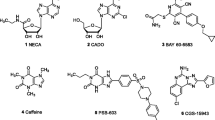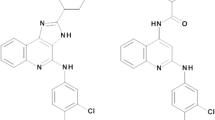Abstract
Purpose. A thermodynamic analysis of the binding to rat cortex adenosine A1, receptor of N6-substituted (full agonists) and N6-substituted-deoxyribose (partial agonists) adenosine derivatives was performed. The intrinsic activity of the compounds was evaluated by measurements of the inhibition of forskolin stimulated 3′, 5′-cyclic adenosine mono-phosphate (c-AMP) levels in isolated epididymal rat adipocytes.
Methods. The thermodynamic parameters ΔG° (standard free energy), ΔH °(standard enthalpy), and ΔS° (standard entropy) of the binding equilibrium were determined by means of affinity measurements carried out at different temperatures (0, 10, 20, 25, 30° C). Levels of c-AMP were evaluated performing competitive protein binding assays.
Results. The binding of the ligands increases with temperature enhancement and, as a consequence, is totally entropy driven. Standard entropy values correlate significantly with intrinsic activity ones.
Conclusions. It is proposed the data obtained by these in vitro experiments can be used to investigate the in vivo pharmacodynamic of A1, full and partial agonists.
Similar content being viewed by others
REFERENCES
B. B. Fredholm, M. P. Abbracchio, G. Burnstock, J. W. Daly, T. K. Harden, K. A. Jacobson, P. Leff, and M. Williams. Nomenclature and classification of purinoceptors. Pharmacol. Rev. 46:143–156 (1994).
K. A. Jacobson, B. K. Trivedi, P. C. Churchill, and M. Williams. Novel therapeutics acting via purinergic receptors. Biochem. Pharmacol. 41:1399–1410 (1991).
C. Heurteaux, I. Lauritzen, C. Widmann, and M. Lazdunski. Essential role of adenosine, adenosine A1 receptors, and ATP-sensitive K+ channels in cerebral ischemic preconditioning. Proc. Natl. Acad. Sci. USA 92:4666–4670 (1995).
A. L. Tucker and J. Linde. Cloned receptors and cardiovascular responses to adenosine. Cardiovasc. Res. 27:54–61 (1993).
P. J. M. Van Galen, G. L. Stiles, G. Michaels, and K. A. Jacobson. Adenosine A1 and A2 receptors: structure-function relationships. Med. Res. Rev. 12:423–471 (1992).
D. Van Calker, M. Muller, and B. Hamprecht. Adenosine regulates via two different types of receptors the accumulation of cyclic AMP in cultured brain cells. J. Neurochem. 33:999–1008 (1979).
P. A. Borea, K. Varani, A. Dalpiaz, A. Capuzzo, E. Fabbri, and A. P. IJzerman. Full and partial agonistic behaviour and thermodynamic binding parameters of adenosine A1 receptor ligands. Eur. J. Pharmacol.-Mol. Pharmacol. Sect. 267:55–61 (1994).
A. P. IJzerman, E. M. van der Wenden, J. K. von Frijtag Drabbe Künzel, R. A. A. Mathôt, M. Danhof, P. A. Borea, and K. Varani. Partial agonism of theophylline-7-riboside on adenosine receptors. Naunyn-Schmiedeberg's Arch. Pharmacol. 350:638–645 (1994).
E. M. Van der Wenden, J. K. von Frijtag Drabbe Künzel, R. A. A. Mathot, M. Danhof, A. P. IJzerman, and W. Soudijn. Ribose-modified adenosine analogues as potential partial agonists for the adenosine receptor. J. Med. Chem. 38:4000–4006 (1995).
R. A. A. Mathot, E. M. van der Wenden, S. W. Soudijn, A. P. IJzerman, and M. Danhof. Deoxyribose analogues of N6-cyclopentyladenosine (CPA): partial agonists at the adenosine A1 receptor in vivo. Br. J. Pharmacol. 116:1957–1964 (1995).
B. Testa. Drugs as chemical messageas: molecular structure, biological context and structure activity relationships. Med. Chem. Res. 7:340–365 (1997).
B. Testa, B. K. Lemont, and P. A. Carrupt. A systems approach to molecular structure, intermolecular recognition and emergence-dissovelvence in medicinal research. Med. Res. Rev. 17:303–326 (1997).
P. H. Van der Graaf and M. Danhof. Analysis of drug-receptor interactions in vivo: a new approach in pharmacokinetic-pharmacodynamic modelling. Int. J. Clin. Pharm. Ther. 35:442–446 (1997).
P. Gilli, V. Ferretti, G. Gilli, and P. A. Borea. Enthalpy-entropy compensation in drug-receptor binding. J. Phys. Chem. 98:1515–1518 (1994).
P. H. Eliard and G. G. Rousseau. Thermodynamics of steroid binding to the human glucocorticoid receptor. Biochem. J. 218:395–404 (1984).
O. H. Lowry, N. J. Rosebrough, A. L. Fazz, and L. Randall. Protein measurement with the Folin phenol reagent. J. Biol. Chem. 123:265–275 (1951).
M. Rodbell. Metabolism of isolated fat cells. I. Effects of hormones on glucose metabolism and lipolysis. J. Biol. Chem. 239:375–382 (1964).
C. Nordstedt and B. B. Fredholm. A modification of a protein binding method for rapid quantification of c-AMP in cell culture supernatants and body fluids. Anal Biochem. 189:231–236.
Y. C. Cheng and W. H. Prusoff. Relationships between the inhibition constant (Ki) and the concentration of inhibitor which cause 50 percent inhibition (IC50) of an enzymatic reaction, Biochem. Pharmacol. 22:3099–3108 (1973).
M. J. Lohse, V. Lenschow, and U. Schwabe. Two affinity states of Ri adenosine receptors in Brain membranes. Analysis of guanine nucleotide and temperature effects on radioligand binding. Mol. Pharmacol. 26:1–9 (1984).
G. Milligan, R. A. Bond, and M. Lee. Inverse agonism: pharmacological curiosity or potential therapeutic strategy? Trends Pharmacol. Sci. 16:10–13 (1995).
P. A. Borea, A. Dalpiaz, K. Varani, S. Gessi, and G. Gilli. Binding thermodynamics at A1 and A2A adenosine receptors. Life Sci. 59:1373–1388, 1996.
J. M. Sturtevant. Heat capacity and entropy changes in processes involving proteins, Proc. Natl. Acad. Sci. USA 74:2236–2241 (1977).
P. A. Borea, K. Varani, L. Guerra, P. Gilli, and G. Gilli. Binding thermodynamics of A1 adenosine receptor ligands. Mol. Neuropharmacol. 2:273–281 (1992).
A. Dalpiaz, K. Varani, P. A. Borea, C. Martini, G. Chiellini, and A. Lucacchini. Biochemical and pharmacological characterization of periodate-oxidized adenosine analogues at adenosine A1 receptors. Biochim. Biophis. Acta 1267:145–151 (1995).
Author information
Authors and Affiliations
Corresponding author
Rights and permissions
About this article
Cite this article
Dalpiaz, A., Scatturin, A., Pavan, B. et al. Thermodynamic In Vitro Studies as a Method to Investigate the Pharmacodynamic Behavior of Adenosine A1 Receptor Ligands. Pharm Res 16, 1054–1058 (1999). https://doi.org/10.1023/A:1018987816891
Issue Date:
DOI: https://doi.org/10.1023/A:1018987816891




